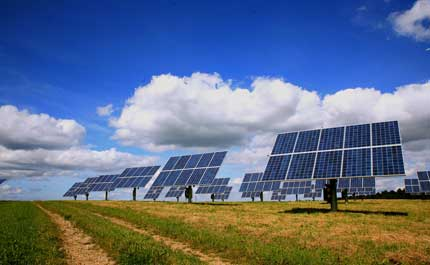Ray of hope shines on China's solar industry
 0 Comment(s)
0 Comment(s) Print
Print E-mail Xinhua, October 31, 2012
E-mail Xinhua, October 31, 2012
|
 |
|
According to the World Council for Renewable Energy, the Chinese solar industry has no home market and exports all its production. |
China's once red-hot solar industry is feeling the chill. The possible establishment of new business partnerships amid a recent wave of supportive government initiatives, however, may raise the industry's chances for recovery.
Jiangxi Province-based LDK Solar is one of the world's largest producers of solar wafers. With its net losses almost doubling in the second quarter and a debt ratio of 93 percent in the first half, the company has chosen to sell 19.9 percent of its shares to a state-backed company.
The deal will generate an immediate US$23 million and help with a tight cash flow, said Sam Tong, LDK's president and chief operating officer.
The Chinese market has been filled with speculation regarding possible moves to be made by other solar companies, including Dongying, Shandong-based CNPV and Suntech Power, the world's largest maker of solar cells.
After a wave of investment, many Chinese photovoltaic (PV) manufacturers idled production in the second half of 2011 because of severe overcapacity, according to the China Photovoltaic Industry Alliance, a trade group.
In an extreme case often cited by industry observers, Langsha and Bosideng, companies that made their names in China manufacturing apparel, announced plans to enter the solar power industry several years ago.
"When demand for solar panels skyrocketed prior to 2008, production of polysilicon, a key component, snowballed in China with nearly 300 billion yuan pouring into 43 newly established enterprises," said Zhu Gongshan, chairman of the trade group.
"But 2009 came and the price of polysilicon plunged. More than 30 enterprises were forced to stop production within just one year of being established," Zhu said.
Adding to the industry's woes, the European Union in September brought its biggest ever trade case against China, alleging the country has dumped solar panels in Europe.
This month, the US Commerce Department also decided to impose heavy tariffs on Chinese solar panels.
"Until now, China had no home market. The Chinese module industry had to export all its production," said Wolfgang Palz, chairman of the World Council for Renewable Energy and a former adviser to the European Union Commission on renewable energy.
"Thanks to the dynamism of the Chinese PV module industry, prices have come down so much that PV is progressively getting economically competitive on the markets," Palz said.
Inadequate support
In stark contrast with allegations by Western competitors that Chinese companies have been granted so many privileges by the state that they are able to "dump" products in developed countries, many industry insiders have complained of inadequate support and policy hurdles within China.
The ten largest solar companies in China have accumulated a total of US$17.5 billion in debt, according to numbers compiled in August by Maxim Group, a US-based investment bank.
"Seeking approval is complicated and takes considerable time. This hurts investor enthusiasm," said Shi Zhengrong, founder and executive chairman of Suntech.
After signing a contract in 2009 to invest in a solar power plant in Aula County in Qinghai Province, it took Suntech two years to secure the necessary government approval.
"Without a coordinating industrial policy and institution, enterprises need to go to government authorities one by one," said Wang Shun, vice chairman of Hanergy, China's largest privately held clean energy firm.
Another key hurdle is the difficulty of connecting solar power plants to China's electric grid. Official figures indicate that 25 percent of the power generating capacity of new solar plants in 2011 went unused because the plants could not maintain a connection with the grid.
"For a long time, Chinese solar companies have been fighting on their own. In light of a new market horizon, especially taking into account protectionism in the US and EU, forming strategic partnerships with others might be a wise choice now," said Zhou Lang, a solar expert at Nanchang University.
Turnaround?
LDK's sale of shares to a state-backed company also involved Hi-Tech Wealth, a leading integrated multi-channel sales and marketing group in China.
Sinoma International Engineering, a Shanghai-listed company principally engaged in the manufacture and distribution of mechanical equipment, announced last week that it will sign a framework agreement to join LDK in exploring the solar business.
PV panels are installed at solar power plants to generate electricity, and China is still "big in production, small in application" in terms of tapping solar power, said Chu Junhao, a scientist specializing in solar energy and an academic at the Chinese Academy of Sciences.
"China's Energy Policy 2012," a government white paper on energy policy reaffirmed the country's commitment to developing the full potential of solar power.
By 2015, China plans to boost its solar power generating capacity sevenfold, according to the paper, which was issued by the Information Office of the State Council.
China State Grid Corp, China's largest power grid operator, announced a series of measures to facilitate the connection of solar power plants to the electric grid, breaking the bottleneck that has stifled domestic demand for solar panels.
State Grid will pay for investment related to connecting the plants to the grid as long as they meet certain standards, potentially boosting the utilization of distributed solar power plants and related industries.






Go to Forum >>0 Comment(s)